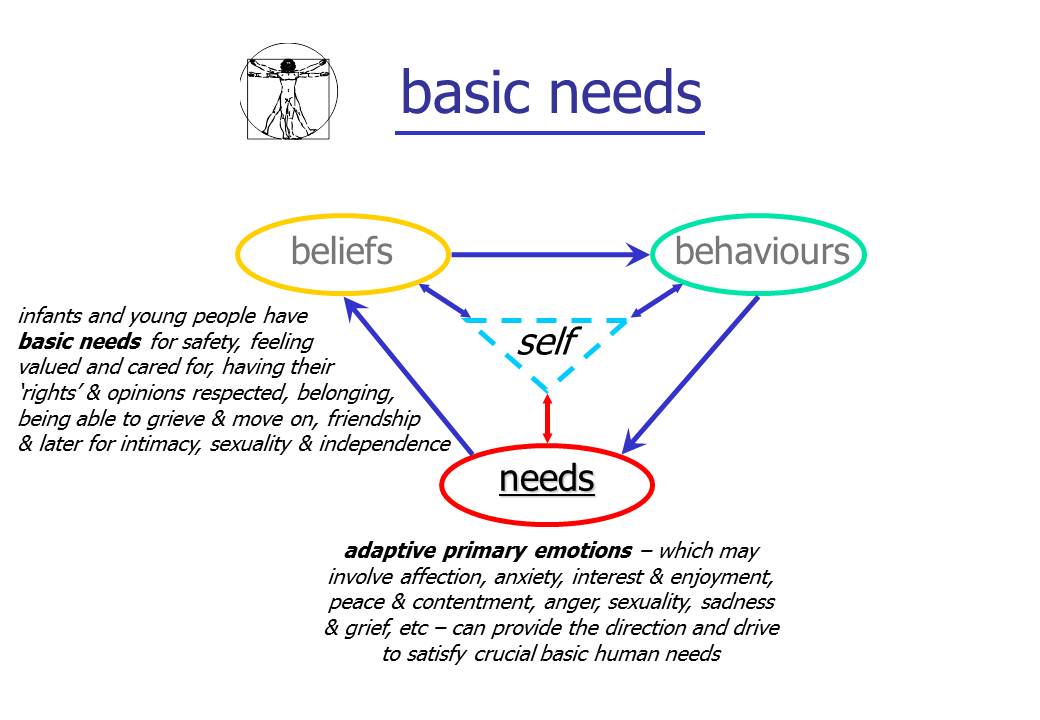Our life stories: needs, beliefs & behaviours - part three, "behaviours"
Last updated on 21st September 2010

I posted yesterday on the first, "Needs" section of the "Needs, beliefs, behaviours" diagram (below). Today I want to say a little about the second section of the diagram - "Beliefs".
This diagram is downloadable both as a Powerpoint slide and as a PDF file.
This is the first of a series of four brief posts giving more information about a model I use a lot, especially when working with people who are trying to change long term personality patterns. The ideas aren't at all original, although this particular way of presenting them is my own. So the first step in the model is "needs". This is illustrated in the following diagram:

This diagram is downloadable both as a Powerpoint slide and as a PDF file.
I wrote earlier this month on "Attachment, compassion & relationships". I've been aware of John Bowlby's work on adult-child attachment for many years but, when I've approached it for insights that might help in my work as a psychotherapist, I've been put off by the complexity of assessment methods and variety of reported attachment styles, as well as by the rapidly growing size of the relevant academic literature. As Jude Cassidy and Phillip Shaver write in their preface to the 2008 meister work "Handbook of attachment (2nd ed)" - see more details at the end of this blog post - "Anybody who conducts a literature search on the topic of 'attachment' will turn up more than 10,000 entries since 1975, and the entries will be spread across scores of physiological, clinical, developmental, and social psychology journals, will include numerous
Well I didn't sleep too well last night. Catero, my wife, and I went to the cinema yesterday evening and watched "500 Days of Summer" . I enjoyed it and it got me thinking about relationships. The "Summer" of the title is a woman who doesn't believe in romantic love. She's kind of charming and maddening and, as I biked away from the cinema, I wondered how I would have approached treating her if she had come to me for therapy! Interestingly a newspaper reviewer commented that the film is "weirdly incurious about the inner life of its female lead".
If you would like a printable handout of this blog post click here.
Last week I talked about coming across Srivastava and colleagues' paper (Srivastava, Tamir et al. 2009 - see below) on the social costs of emotional suppression. This led me to Srivastava's lab at the University of Oregon. It's then an easy jump to James Gross's Psychophysiology lab at Stanford University (see below). The Stanford lab is a hive of activity with research projects in a whole series of fascinating areas . A key focus is work on emotion regulation - its neural basis, emotional & social consequences, and relationship with personality. Their "process model of emotion regulation" suggests that " ...
I love it when I follow up ideas from a new research paper and then break through into a whole area of helpful knowledge that I haven't come across before. This happened recently with the paper by Srivastava and colleagues (Srivastava, Tamir et al. 2009 - see below) on the social costs of emotional suppression. This then linked me through to James Gross's work at Stanford, but more on that in next week's post.
Here are a set of diverse handouts and questionnaires on emotions, schema and personality. The "triangle of emotions" is a model I put together to help guide work on the longer term dysfunctional personality patterns that we probably all experience to some extent. The "big five" is a very widely used way of assessing personality, and this "ten aspects" version I find particularly interesting. There are then a series of handouts from Arnoud Arntz's fine work on understanding and treatment of borderline personality disorder. I have found that Arntz's ideas seem more broadly helpful than just with borderline (which anyway is a poor descriptor for this emotional regulation disorder). There are also some sheets derived from Young's associated work on schema.